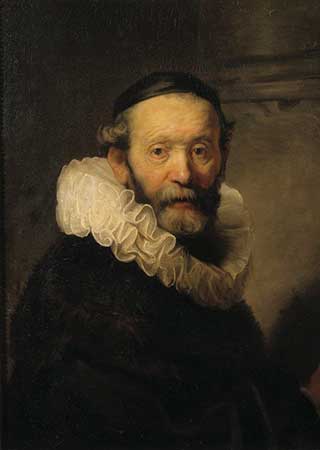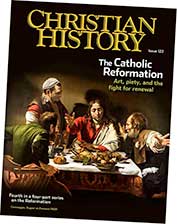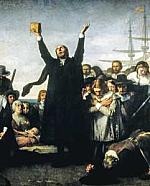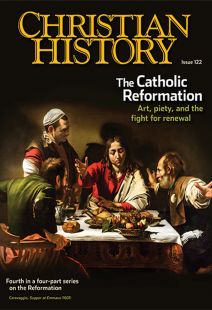Defender of God’s justice

[Remonstrant Johannes Uyttenbogaert; Wikipedia]
THE NAME JACOB ARMINIUS (1559–1609) still provokes resistance in Calvinist circles, most notably because many Calvinists say he awarded a decisive role to man’s free will in salvation at the cost of God’s sovereign grace. The real story, as so often is the case, is more complex.
When did God choose?
Though we know him today by the Latin version of his Dutch name, Arminius was born Jakob Hermanszoon in 1559 in Oudewater in the Netherlands. His father died around that time; later he lost his mother, sister, and older brothers in the Spanish massacre of Oudewater in 1575, escaping because he was studying at Marburg. In 1576 Arminius enrolled at the University of Leiden; in 1582 he moved to the University of Geneva under Calvin’s renowned disciple Theodore Beza; and six years later, he was ordained in Amsterdam.
Around 1590 Arminius started to doubt Beza’s influential “supralapsarian” doctrine of predestination—the idea that God’s election to salvation logically preceded God’s knowledge of the Fall. Dutch theologian Dirck Coornhert (1522–1590) objected that Beza’s doctrine made God unjust: if God elected or rejected people who are not yet fallen, the Fall would necessarily result, making God, and not humans, responsible for sin.
Some who wanted to take the sting out of Coornhert’s criticism proposed that predestination was God’s gracious response to his foreknowledge that the Fall would occur (“infralapsarianism”). Arminius agreed with Coornhert’s criticism of Beza, but not with the alternative solution.
God’s justice increasingly became the foundation of Arminius’s theology. He argued that God is just in his very essence; his justice is so fundamental that it characterizes all God’s will and actions. God’s will is completely free, but this can never result in God willing something unjust.
Arminius outlined salvation this way: God gave us free will and made an agreement that, on condition of total obedience, we would be joyfully united with God. He gave us all we need to stay obedient, but voluntarily we broke the covenant, deserving damnation. Nevertheless God wanted to show mercy. The only way to do this without compromising justice was through the substitutionary suffering and death of Jesus as mediator, appeasing God’s justice in our place.
Through faith Christ’s righteousness would be applied to us: God elects believing sinners and rejects unbelieving sinners. The new covenant that God made with us after the Fall included the gift of all the means of grace that we need to believe in Christ, to repent, and to be saved.
For Arminius this, too, was linked to God’s justice: God did not exclude anyone when he made the new covenant. God demands faith in Christ from all people, and it would be unjust if God did not grant the grace necessary to meet the demand. Moreover God determined that those who do not believe in Christ should be punished eternally, and it would be unjust if God punished us for not doing something when we had no possibility whatsoever to act differently.
Following the teaching of theologian Peter Martyr Vermigli (1499–1562), the predominant opinion in Arminius’s day was that the absence of coercion establishes responsibility. If you do something spontaneously, you are responsible, even if you don’t have the ability to act differently. Arminius did not share this opinion. But he was convinced (as were his colleagues) that the Fall had very serious consequences: despite free will, we could never choose the good if God through grace did not free the will from the bonds of sin.
God’s twofold love
Arminius described the foundation of Christian religion as God’s twofold love. God wants all to be saved (his second love), but not at the expense of his justice (his first love). Arminius thought that the doctrine of unconditional predestination reverses the priority of the two aspects, asserting that God loves humans and wills their salvation before God’s justice has been logically satisfied by the sacrifice of Christ.
Arminius did not want anyone to think God could be the cause of sin and evil. To him such a thought was the greatest blasphemy imaginable. Calvin, especially, had been accused that his theology made God the cause of sin. Calvin responded: who are we to measure the justice of God’s actions? God determines what is just. Other Reformed theologians were not satisfied with this appeal to mystery. Many very subtle distinctions were put forward to prove that God, in spite of appearances to the contrary, is not the author of sin.
But the view propounded by Calvin, Beza, Vermigli, and others was increasingly accepted. For theologians who thought differently, this sometimes led to a voluntary—or forced—departure of the dissenters from their posts or from the church.
Arminius recognized that it was not Calvin’s intention, nor that of his colleagues, to make God the author of sin. Yet he was convinced that this was causing many to turn their backs on the Reformed Church and creating a stumbling block for others who wished to join. For Arminius God’s justice was not a confession of faith that must be adhered to against all apparent injustice by God, but a revelation from God that formed the grounds for faith and trust in him and his honor.
Criticism of Arminius, already present when he was minister in Amsterdam, intensified when he was appointed professor of theology at the University of Leiden in 1603. Although his colleague Franciscus Gomarus (1563–1641) resolved the clashes, the same Gomarus sharply criticized Arminius for his view of predestination as early as 1604.
This caused much uneasiness at the university, in the church, and in local politics. The States (representatives of Holland and West–Friesland) tried to mediate. Arminius made a theological declaration before the States in 1608. It was one of his last writings: tuberculosis, from which he had suffered for years, killed him in 1609.
Five flowering points
Arminius’s death did not bring about the end of the conflict. In January 1610 around 40 ministers, led by Johannes Wtenbogaert (1557–1644), summarized their views on these themes and presented their document to the States. The five points in which they disclosed their views became known as the Five Articles of Remonstrance. Those who held them became known as “Remonstrants.” The opposition was called the “Counter-Remonstrants.”
Order Christian History #122: The Catholic Reformation in print.
Subscribe now to get future print issues in your mailbox (donation requested but not required).
The five controversial themes for the most part derived directly from Arminius’s views on predestination, atonement, grace, the operation of grace, and perseverance. With the early Remonstrants, one could still recognize Arminius’s attention to God’s justice, but eventually this framework vanished. Nor did the Counter-Remonstrants use God’s justice as their starting point. The controversial themes started to have a life of their own.
Finally a synod was called in November 1618 by the Dutch Reformed Church at the city of Dordrecht, or Dort, to deal with the matter. Reformed theologians from eight foreign churches (including the Church of England) also attended. The synod met until May of 1619 and, after debate, condemned the Remonstrants’ position in terms that would became famous as the “five points of Calvinism.”
The Remonstrants who had attended the synod were told to cease from serving as ministers (they agreed) and to stop spreading their doctrines (they resisted). Their political protector, Johan van Oldenbarnevelt (1547–1619), was beheaded shortly after the synod ended, and across Holland over 200 Remonstrant pastors were deprived of their positions and in some cases imprisoned or banished. The Remonstrant position would not become legal in Holland until 1795.
Meanwhile Arminianism (as it became called) lived on outside Holland. The Remonstrant version grew in influence in the Church of England; and the early English General Baptists, especially Thomas Helwys (c. 1575–c. 1616), expressed a version closer to Arminius’s own. And a little more than a century later, another theologian, who didn’t mean to launch a movement either, would use the term to describe his thoughts on predestination—whether thoroughly reconcilable with Arminius’s original teachings or not. You may have heard of him. His name was John Wesley. CH
This article is from Christian History magazine #122 The Catholic Reformation. Read it in context here!
Christian History’s 2015–2017 four-part Reformation series is available as a four-pack. This set includes issue #115 Luther Leads the Way; issue #118 The People’s Reformation; issue #120 Calvin, Councils, and Confessions; and issue#122 The Catholic Reformation. Get your set today. These also make good gifts.
By William den Boer
[Christian History originally published this article in Christian History Issue #122 in 2017]
William den Boer is a postdoctoral researcher in church history at the Theological University of Kampen and the author of God’s Twofold Love: The Theology of Jacob Arminius (1559–1609).Next articles
Remaking the world
Five men with very different ideas on the reform of Sixteenth-century Catholicism
Edwin and Jennifer Woodruff TaitThe Catholic Reformation: Recommended Resources
Here are some recommendations from CH editorial staff and this issue’s authors to help you navigate the landscape of the Catholic Reformation and the effects of reform on into the seventeenth century.
the editorsThree featured paintings
Three paintings that put Comenius’s life and times in perspective.
the editorsSupport us
Christian History Institute (CHI) is a non-profit Pennsylvania corporation founded in 1982. Your donations support the continuation of this ministry
Donate








